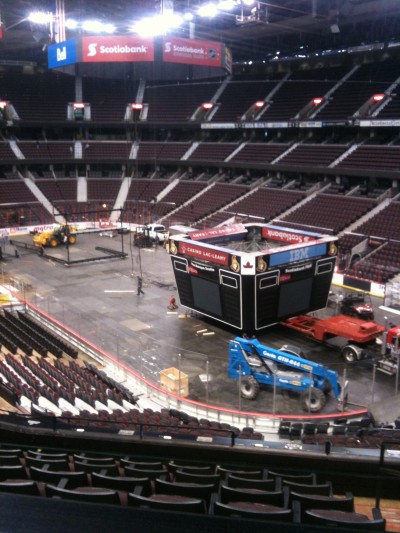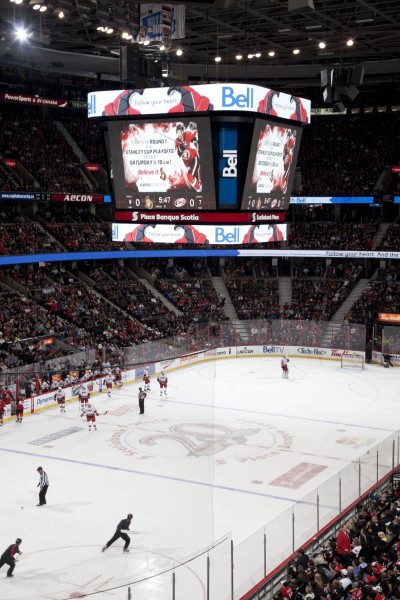Scotiabank Place
In 1996, the patience of hockey fans in Canada’s capital region was rewarded with the construction of a large new venue to house the National Hockey League’s (NHL’s) Ottawa Senators, as well as to host other major events. Local software developer Corel became the first major sponsor of this building.
Then named the Palladium, the facility represented a mammoth undertaking just outside Ottawa’s downtown core, constructed on farmland in the steadily growing suburb of Kanata. Boasting more than 19,000 seats, the new venue meant the Senators would finally have a home on par with those of other NHL clubs, to better meet demand in one of the strongest hockey markets anywhere in the world.
Much has changed since then, including a number of sponsorship deals and facelifts for the stadium over the years. When Scotiabank took over the naming rights in 2006, for example, the Palladium became Scotiabank Place. With such name changes came the need to replace signage throughout the arena, ranging from indoor displays to the building’s massive outdoor façade facing Highway 417.
At the beginning of the 2011/2012 hockey season, Scotiabank Place announced plans to upgrade the arena’s AV capabilities by replacing its scoreboard with a new, HD-capable structure that would overhang centre ice, complemented by the addition of interactive LED ‘ribbon’ features. This $5-million project was the next step in terms of keeping the arena on par with newer NHL venues.
Icon HD, again, was awarded the contract in conjunction with Panasonic to provide the HD LED screens. Both companies had past experience and expertise working with sports venues. Signs.ca was brought on board with responsibility to dismantle the old scoreboard while Icon HD and Panasonic assembled the new structure. Signs.ca also provided and incorporated the rest of the new signage.
The sign package was extensive and intricate. The existing 27.9 m2 (300 sf) of video board faces were replaced with new HD screens totalling more than 195 m2 (2,100 sf), sponsored by Bell Canada and Scotiabank. Two LED ribbon displays were specified, one above and one below the video screens.
A 6 x 6-m (20 x 20-ft) LED-illuminated dimensional Scotiabank Place logo was fastened to the bottom of the structure. Four sets of 762-mm (30-in.) tall channel letters, each spelling out ‘Bell,’ were mounted vertically onto backer panels in the corners. Finally, four sets of illuminated Scotiabank Place ‘name rings’ were attached, one to each face of the scoreboard.
The large, dimensional logo on the scoreboard’s bottom panel was designed with formed faces for the ‘flying’ letter S and 38-mm (1.5-in.) acrylic returns were used to achieve a glowing effect—similar to the effect that would be created later with the Mosaic Stadium letters—and a sense of prominence for the arena’s main sponsor. As Bell was another main contributor to the scoreboard project, the channel letters spelling out its name were designed in a similar fashion, with acrylic returns, and acted as ‘covers’ for the structure holding the large screens.
Once the framework was complete, Signs.ca was also tasked with custom-forming aluminum covers for all of the exposed metal that fastened the LED screens in place. This involved polishing the remaining components.
Between the stadium’s hockey games, concerts and other events, it was difficult to find time to remove the existing scoreboard structure and install all of the new components, once they had been fabricated. The only break in the venue’s schedule in late 2011 came with two days at Christmas.
This meant the crew would have no more than 48 hours to dismantle and remove the old scoreboard and install the new structure. The installers worked around the clock to deliver this ‘Christmas present’ to Ottawa Senators fans, who returned to the venue for a game against the Montreal Canadiens. And soon thereafter, in January 2012, the scoreboard was showcased to hockey fans everywhere when Ottawa hosted the Tim Hortons NHL All-Star Game. The stadium’s new LED screens’ display capabilities were used to support the event’s many multimedia needs, with team representatives, sponsors and everyone else involved in the project looking above centre ice.







